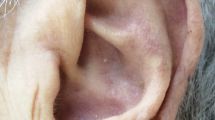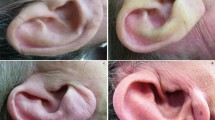Abstract
Frank’s sign is a diagonal crease of the ear lobe, supposedly related to cardiac pathology, and has strongly been associated with coronary artery atherosclerosis. A total of 45 consecutive adult patients referred for autopsy in a one-and-a-half-year period were extensively studied. Samples from both the ear lobes were obtained for histopathology, as well as cardiac samples from all four cardiac compartments. When compared patients with Frank’s sign and those without it had no statistical difference in age (p = 0.0575). There was however a statistically significant increased cardiac weight (p = 0.0005), left ventricular wall thickness (p = 0.0002), and right ventricular wall thickness (p = 0.0043). Histopathology obtained from the ear lobes revealed myoelastofibrosis in an arterial vessel, located at the base of the crease, diffuse fibrosis, and Wallerian-like degeneration, with eosinophilic inclusions in the peripheral nerves. These changes suggest a time-related progression of the crease-associated changes. Our data suggest a significant correlation between the morphological changes of the myocardium and the presence of the ear lobe creases, with arterial myoelastofibrosis, Wallerian-like degeneration in peripheral nerves and deep tissue fibrosis found in the base of the crease.



Similar content being viewed by others
References
Frank ST. Aural sign of coronary-artery disease. N Engl J Med. 1973;289:327–8. https://doi.org/10.1056/nejm197308092890622.
Baboujian A, Bezwada P, Ayala-Rodriguez C. Diagonal earlobe crease, a marker of coronary artery disease: a case report on Frank’s sign. Cureus. 2019;11:e4219. https://doi.org/10.7759/cureus.4219.
Griffing G. Frank’s sign. N Engl J Med. 2014;370:e15. https://doi.org/10.1056/NEJMicm1213868.
Pathmarajah P, Rowland Payne C. Paired Ear Creases of the Helix (PECH): a possible physical sign. Cureus. 2017;9:e1884. https://doi.org/10.7759/cureus.1884.
Lin AN, Lin K, Kyaw H, Abboud J. A myth still needs to be clarified: a case report of the Frank’s sign. Cureus. 2018;10:e2080. https://doi.org/10.7759/cureus.2080.
Shoenfeld Y, Mor R, Weinberger A, Avidor I, Pinkhas J. Diagonal ear lobe crease and coronary risk factors. J Am Geriatr Soc. 1980;28:184–7. https://doi.org/10.1111/j.1532-5415.1980.tb00514.x.
Petrakis NL. Diagonal earlobe creases, type A behavior and the death of Emperor Hadrian. West J Med. 1980;132:87–91.
Davis TM, Balme M, Jackson D, Stuccio G, Bruce DG. The diagonal ear lobe crease (Frank’s sign) is not associated with coronary artery disease or retinopathy in type 2 diabetes: the Fremantle Diabetes Study. Aust N Z J Med. 2000;30:573–7. https://doi.org/10.1111/j.1445-5994.2000.tb00858.x.
Edston E. The earlobe crease, coronary artery disease, and sudden cardiac death: an autopsy study of 520 individuals. Am J Forensic Med Pathol. 2006;27:129–33. https://doi.org/10.1097/01.paf.0000221067.73173.d7.
Nazzal S, Hijazi B, Khalila L, Blum A. Diagonal earlobe crease (Frank’s sign): a predictor of cerebral vascular events. Am J Med. 2017;130:1324. https://doi.org/10.1016/j.amjmed.2017.03.059.
Wakasugi M, et al. Prevalence of earlobe creases and their association with history of cardiovascular disease in patients undergoing hemodialysis: a cross-sectional study. Ther Aphere Dial. 2017;21:478–84. https://doi.org/10.1111/1744-9987.12567.
Patel V, Champ C, Andrews PS, Gostelow BE, Gunasekara NP, Davidson AR. Diagonal earlobe creases and atheromatous disease: a postmortem study. J R Coll Physcians Lond. 1992;26:274–7.
Rodríguez-López C, Garlito-Díaz H, Madroñero-Mariscal R, Sánchez-Cervilla PJ, Graciani A, López-Sendón JL, López-de-Sá E. Earlobe crease shapes and cardiovascular events. Am J Cardiol. 2015;116:286–93. https://doi.org/10.1016/j.amjcard.2015.04.023.
Agouridis AP, Elisaf MS, Nair DR, Mikhailidis DP. Ear lobe crease: a marker of coronary artery disease? Arch Med Sci. 2015;11:1145–55. https://doi.org/10.5114/aoms.2015.56340.
Wood-Jones F, I-Chuan W. The development of the external ear. J Anat. 1934;68:525–353.
Wright CG. Development of the human external ear. J Am Acad Audiol. 1997;8:379–82.
Fraser FC, Sproule JR, Halal F. Frequency of the branchio-oto-renal (BOR) syndrome in children with profound hearing loss. Am J Med Genet. 1980;7:341–9. https://doi.org/10.1002/ajmg.1320070316.
Fumiiri M, Hyakusoku H. Congenital auricular cleft. Plast Reconstr Surg. 1983;71:249–50. https://doi.org/10.1097/00006534-198302000-00019.
Heathcote JA. Why do old men have big ears? BMJ. 1995;311:1668. https://doi.org/10.1136/bmj.311.7021.1668.
Garikipati VNS, Verma SK, Kishore R. The nervous heart: role of sympathetic reinnervation in cardiac regeneration. Circul Res. 2015;117:980–1. https://doi.org/10.1161/CIRCRESAHA.115.307637.
Overfield T, Call EB. Earlobe type, race, and age: effects on earlobe creasing. J Am Geriatr Soc. 1983;31:479–81. https://doi.org/10.1111/j.1532-5415.1983.tb05121.x.
Acknowledgements
The authors would like to thank the reviewers for their comment and suggestion, which represent an enormous contribution to the manuscript.
Author information
Authors and Affiliations
Contributions
All authors contributed to the study conception and design. Material preparation, data collection, and analysis were performed by GS, LP, and DD. The first draft of the manuscript was written by GS and all authors commented on previous versions of the manuscript. All authors read and approved the final manuscript.
Corresponding author
Ethics declarations
Conflict of interest
The authors declare that they have no competing interest.
Ethical Approval
All procedures contributing to this work complied with the ethical standards of the Helsinki declaration of 1964 and its seventh revision from 2013, the ethical standards of the Bulgarian Ministry of Healthcare, as well as the ethical standards and protocols of the St. Marina University Hospital, Varna, Bulgaria.
Additional information
Publisher's Note
Springer Nature remains neutral with regard to jurisdictional claims in published maps and institutional affiliations.
Rights and permissions
About this article
Cite this article
Stoyanov, G.S., Dzhenkov, D., Petkova, L. et al. The Histological Basis of Frank’s Sign. Head and Neck Pathol 15, 402–407 (2021). https://doi.org/10.1007/s12105-020-01205-4
Received:
Revised:
Accepted:
Published:
Issue Date:
DOI: https://doi.org/10.1007/s12105-020-01205-4




